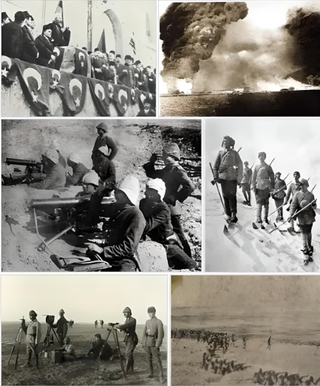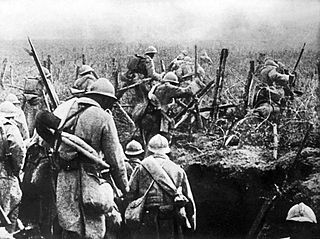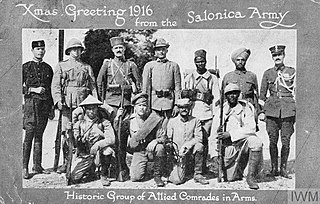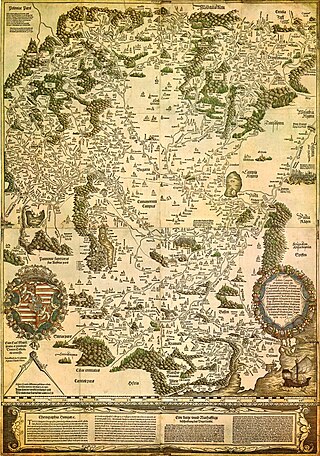
The Central Powers, also known as the Central Empires, were one of the two main coalitions that fought in World War I (1914–1918). It consisted of the German Empire, Austria-Hungary, the Ottoman Empire, and Bulgaria; this was also known as the Quadruple Alliance.

The Treaty of Brest-Litovsk was a separate peace treaty signed on 3 March 1918 between Soviet Russia and the Central Powers, by which Russia withdrew from World War I. The treaty, which followed months of negotiations after the armistice on the Eastern Front in December 1917, was signed at Brest-Litovsk.

The Triple Alliance was a defensive military alliance between Germany, Austria-Hungary, and Italy. It was formed on 20 May 1882 and renewed periodically until it expired in 1915 during World War I. Germany and Austria-Hungary had been closely allied since 1879. Italy was looking for support against France shortly after it lost North African ambitions to the French. Each member promised mutual support in the event of an attack by any other great power. The treaty provided that Germany and Austria-Hungary were to assist Italy if it was attacked by France without provocation. In turn, Italy would assist Germany if attacked by France. In the event of a war between Austria-Hungary and Russia, Italy promised to remain neutral.

The Triple Entente describes the informal understanding between the Russian Empire, the French Third Republic, and the United Kingdom of Great Britain and Ireland. It was built upon the Franco-Russian Alliance of 1894, the Entente Cordiale of 1904 between France and Britain, and the Anglo-Russian Entente of 1907. It formed a powerful counterweight to the Triple Alliance of the German Empire, the Austro-Hungarian Empire, and the Kingdom of Italy. The Triple Entente, unlike the Triple Alliance or the Franco-Russian Alliance itself, was not an alliance of mutual defence.

The Treaty of London or the Pact of London was a secret agreement concluded on 26 April 1915 by the United Kingdom, France, and Russia on the one part, and Italy on the other, in order to entice the latter to enter World War I on the side of the Triple Entente. The agreement involved promises of Italian territorial expansion against Austria-Hungary, the Ottoman Empire and in Africa where it was promised enlargement of its colonies. The Entente countries hoped to force the Central Powers – particularly Germany and Austria-Hungary – to divert some of their forces away from existing battlefields. The Entente also hoped that Romania and Bulgaria would be encouraged to join them after Italy did the same.

The Eastern Front or Eastern Theater of World War I was a theater of operations that encompassed at its greatest extent the entire frontier between Russia and Romania on one side and Austria-Hungary, Bulgaria, the Ottoman Empire, and Germany on the other. It ranged from the Baltic Sea in the north to the Black Sea in the south, involved most of Eastern Europe, and stretched deep into Central Europe. The term contrasts with the Western Front, which was being fought in Belgium and France.

The identification of the causes of World War I remains a debated issue. World War I began in the Balkans on July 28, 1914, and hostilities ended on November 11, 1918, leaving 17 million dead and 25 million wounded. Moreover, the Russian Civil War can in many ways be considered a continuation of World War I, as can various other conflicts in the direct aftermath of 1918.

The Entente, or the Allies, were an international military coalition of countries led by France, the United Kingdom, Russia, the United States, Italy, and Japan against the Central Powers of Germany, Austria-Hungary, the Ottoman Empire, and Bulgaria in World War I (1914–1918).

The Middle Eastern theatre of World War I saw action between 30 October 1914 and 30 October 1918. The combatants were, on one side, the Ottoman Empire, with some assistance from the other Central Powers; and on the other side, the British as well as troops from the British Dominions of Australia, Canada, and New Zealand, the Russians, and the French from among the Allied Powers. There were five main campaigns: the Sinai and Palestine, Mesopotamian, Caucasus, Persian, and Gallipoli campaigns.

The Balkans theatre or Balkan campaign was a theatre of World War I fought between the Central Powers and the Allies.

World War I or the First World War was a global conflict between two coalitions: the Allies and the Central Powers. Fighting took place throughout Europe, the Middle East, Africa, the Pacific, and parts of Asia. One of the deadliest wars in history, it resulted in an estimated 9 million soldiers dead and 23 million wounded, plus up to 8 million civilian deaths from numerous causes including genocide. The movement of large numbers of troops and civilians during the war was a major factor in spreading the 1918 Spanish flu pandemic.

The Kingdom of Romania was neutral for the first two years of World War I, entering on the side of the Allied powers from 27 August 1916 until Central Power occupation led to the Treaty of Bucharest in May 1918, before reentering the war on 10 November 1918. It had the most significant oil fields in Europe, and Germany eagerly bought its petroleum, as well as food exports.

Although considerable conflict took place outside Europe, the European theatre was the main theatre of operations during World War I and was where the war began and ended. During the four years of conflict, battle was joined by armies of unprecedented size equipped with new mechanized technologies, leaving tens of millions dead or wounded.

The Macedonian front, also known as the Salonica front, was a military theatre of World War I formed as a result of an attempt by the Allied Powers to aid Serbia, in the autumn of 1915, against the combined attack of Germany, Austria-Hungary and Bulgaria. The expedition came too late and with insufficient force to prevent the fall of Serbia and was complicated by the internal political crisis in Greece. Eventually, a stable front was established, running from the Albanian Adriatic coast to the Struma River, pitting a multinational Allied force against the Bulgarian army, which was at various times bolstered with smaller units from the other Central Powers. The Macedonian front remained stable, despite local actions, until the Allied offensive in September 1918 resulted in Bulgaria capitulating and the liberation of Serbia.

The Kingdom of Bulgaria participated in World War I on the side of the Central Powers from 14 October 1915, when the country declared war on Serbia, until 30 September 1918, when the Armistice of Salonica came into effect.

Although a member of the Triple Alliance, Italy did not join the Central Powers – Germany and Austria-Hungary – when the war started with Austria-Hungary's declaration of war on Serbia on 28 July 1914. In fact, the two Central Powers had taken the offensive while the Triple Alliance was supposed to be a defensive alliance. Moreover the Triple Alliance recognized that both Italy and Austria-Hungary were interested in the Balkans and required both to consult each other before changing the status quo and to provide compensation for whatever advantage in that area: Austria-Hungary did consult Germany but not Italy before issuing the ultimatum to Serbia, and refused any compensation before the end of the war.

At the outbreak of World War I in August 1914, Hungary was part of the Dual Monarchy of Austria-Hungary. Although there are no significant battles specifically connected to Hungarian regiments, the troops suffered high losses throughout the war as the Empire suffered defeat after defeat. The result was the breakup of the Empire and eventually, Hungary suffered severe territorial losses by the closing Trianon Peace Treaty.

The Ottoman Empire came into World War I as one of the Central Powers. The Ottoman Empire entered the war by carrying out a small surprise attack on the Black Sea coast of Russia on 29 October 1914, with Russia responding by declaring war on 2 November 1914. Ottoman forces fought the Entente in the Balkans and the Middle Eastern theatre of World War I. The Ottoman Empire's defeat in the war in 1918 was crucial in the eventual dissolution of the empire in 1922.
The diplomatic history of World War I covers the non-military interactions among the major players during World War I. For the domestic histories of participants see home front during World War I. For a longer-term perspective see international relations (1814–1919) and causes of World War I. For the following (post-war) era see international relations (1919–1939). The major "Allies" grouping included Great Britain and its empire, France, Russia, Italy and the United States. Opposing the Allies, the major Central Powers included Germany, Austria-Hungary, the Ottoman Empire (Turkey) and Bulgaria. Other countries also joined the Allies. For a detailed chronology see timeline of World War I.

Italy entered into the First World War in 1915 with the aim of completing national unity: for this reason, the Italian intervention in the First World War is also considered the Fourth Italian War of Independence, in a historiographical perspective that identifies in the latter the conclusion of the unification of Italy, whose military actions began during the revolutions of 1848 with the First Italian War of Independence.
 French Third Republic (including colonial forces)
French Third Republic (including colonial forces) United Kingdom (including colonial forces)
United Kingdom (including colonial forces) Russian Empire (until March 1917 [lower-alpha 1] )
Russian Empire (until March 1917 [lower-alpha 1] )  Russian Republic (March 1917 - November 1917)
Russian Republic (March 1917 - November 1917) Soviet Russia (November 1917 - March 1918)
Soviet Russia (November 1917 - March 1918) Kingdom of Serbia
Kingdom of Serbia  Kingdom of Italy [lower-alpha 2] (from May 1915) (including colonial forces)
Kingdom of Italy [lower-alpha 2] (from May 1915) (including colonial forces) Kingdom of Belgium (including colonial forces)
Kingdom of Belgium (including colonial forces) United States of America (after April 1917)
United States of America (after April 1917) Kingdom of Montenegro
Kingdom of Montenegro  Empire of Japan
Empire of Japan  Portuguese Republic (March 1916 and after) (including Portuguese colonial forces)
Portuguese Republic (March 1916 and after) (including Portuguese colonial forces) Kingdom of Romania (August 1916 – May 1918, November 1918)
Kingdom of Romania (August 1916 – May 1918, November 1918) Kingdom of Greece (November 1916 for the Government of National Defence; June 1917 for the whole country)
Kingdom of Greece (November 1916 for the Government of National Defence; June 1917 for the whole country) Albania
Albania  Brazil (October 1917 and after)
Brazil (October 1917 and after) Armenia (May 1918 and after)
Armenia (May 1918 and after) Czechoslovakia – See Czechoslovak Legions
Czechoslovakia – See Czechoslovak Legions  Finland (October 1918 and after)
Finland (October 1918 and after) Nepal (soldiers served under the British Indian Army)
Nepal (soldiers served under the British Indian Army) Kingdom of Siam
Kingdom of Siam  San Marino (June 1915 and after)
San Marino (June 1915 and after) Sweden (June 1914-early 1916) (1918)
Sweden (June 1914-early 1916) (1918) Andorra
Andorra  Bolivia (April 1917 and after)
Bolivia (April 1917 and after) China (August 1917 and after)
China (August 1917 and after) Costa Rica (May 1918 and after)
Costa Rica (May 1918 and after) Cuba (April 1917 and after)
Cuba (April 1917 and after) Ecuador (December 1917 and after)
Ecuador (December 1917 and after) Guatemala (April 1918 and after)
Guatemala (April 1918 and after) Liberia (August 1917 and after)
Liberia (August 1917 and after) Haiti (July 1918 and after)
Haiti (July 1918 and after) Honduras (July 1918 and after)
Honduras (July 1918 and after) Nicaragua (May 1918 and after)
Nicaragua (May 1918 and after) Panama (December 1917 and after)
Panama (December 1917 and after) Peru (October 1917 and after)
Peru (October 1917 and after) Uruguay (October 1917 and after)
Uruguay (October 1917 and after)
















